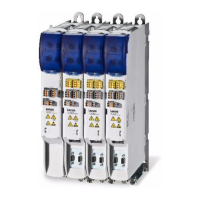Lenze · i700 servo inverter · reference manual · DMS 3.0 EN · 06/2016 · TD06 164
5 Motor control & motor settings
5.16 "Short-circuit braking" function
_ _ _ _ _ _ _ _ _ _ _ _ _ _ _ _ _ _ _ _ _ _ _ _ _ _ _ _ _ _ _ _ _ _ _ _ _ _ _ _ _ _ _ _ _ _ _ _ _ _ _ _ _ _ _ _ _ _ _ _ _ _ _ _
5.16 "Short-circuit braking" function
The control modes for synchronous motors provide the opportunity to use "short-circuit braking" for
the braking process.
Short-circuit braking can be
• parameterised via bit 6 in the Lenze control word (0x2830
or 0x3030 for axis B) or
• as response to light errors. Response of the device in the event of an error
( 279)
Cases of application
• for short-circuit braking via bit 6:
• The braking energy cannot be converted into heat in a brake resistor.
• An external control wants to request short-circuit braking as e.g. an error has been detected
in the encoder system which does not permit braking via quick stop.
• for short-circuit braking as response to light errors:
• Due to an encoder error, no quick stop is possible anymore.
Functional description
The effect of the short-circuit braking on the deceleration behaviour depends on the motor features,
the effective cable length, the mass inertia and the initial value of the speed (application point).
Primarily, short-circuit braking can be used to convert a part of the kinetic energy into heat energy
which serves to unload external brake assemblies and limit position dampers.
Stop!
In some constellations, it is not possible to decelerate the motor speed of a synchronous
motor to zero by means of "short-circuit braking". The braking effect cannot be
compared to the "quick stop" function where the motor is energised under optimal
conditions!
Note!
The short-circuit current is set freely according to the motor voltage (k
E
* speed) and the
internal resistance of the system. Thus, it is mandatory that the ampacity of the i700
servo inverter is oriented towards the short-circuit current to be maximally expected.
Guide value: I
max_device
(3 s) ≥ 1.5 * I
max_motor
(according to the data sheet/catalogue)
In case of a deviating assignment, a rating based on the currently possible parameters
(max. speed, max. motor current, field weakening, etc.) is required!

